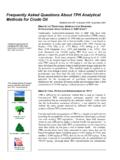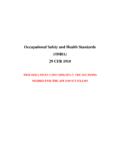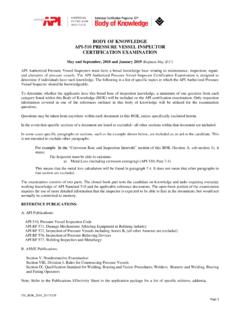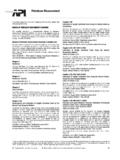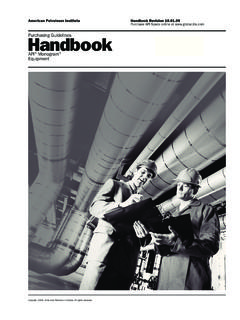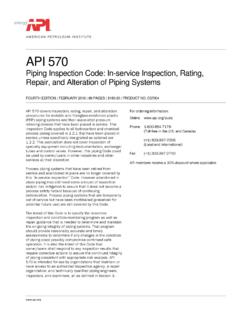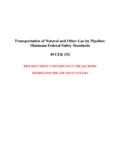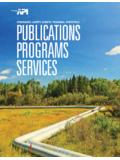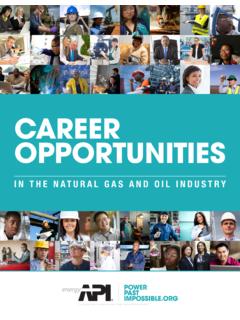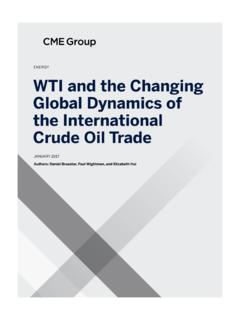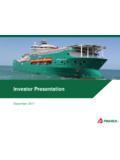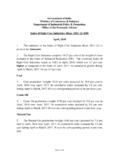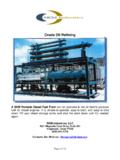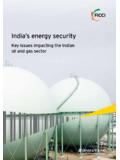Transcription of U.S. OIL AND GAS INFRASTRUCTURE INVESTMENT
1 OIL AND GAS INFRASTRUCTURE INVESTMENTTHROUGH 2035 AN ENGINE FOR ECONOMIC GROWTHSTUDY PREPARED FOR AMERICAN PETROLEUM INSTITUTE Copyright 2017 American Petroleum Institute (API), all rights reserved. Digital Media | DM2017-036 | PDFAPRIL 2017 ICF Authors: Kevin Petak, Harry Vidas, Julio Manik, Srirama Palagummi, Anthony Ciatto, and Andrew Griffith About API: The American Petroleum Institute (API) is the only national trade association that represents all aspects of America s oil and natural gas industry.
2 Our more than 625 corporate members, from the largest major oil company to the smallest of independents, come from all segments of the industry. They are producers, refiners, suppliers, marketers, pipeline operators and marine transporters, as well as service and supply companies that support all segments of the industry. Although our focus is primarily domestic, in recent years our work has expanded to include a growing international dimension, and today API is recognized around the world for its broad range of programs.
3 About ICF: ICF (NASDAQ:ICFI) provides professional services and technology solutions that deliver beneficial impact in areas critical to the world's future. The firm combines passion for its work with industry expertise and innovative analytics to produce compelling results throughout the entire program lifecycle, from research and analysis through implementation and improvement. Since 1969, ICF has been serving government at all levels, major corporations, and multilateral institutions. More than 5,000 employees serve these clients from more than 65 offices worldwide Waivers.
4 Those viewing this Material hereby waive any claim at any time, whether now or in the future, against ICF, its officers, directors, employees or agents arising out of or in connection with this Material. In no event whatsoever shall ICF, its officers, directors, employees, or agents be liable to those viewing this Material. Warranties and Representations. ICF endeavors to provide information and projections consistent with standard practices in a professional manner. ICF MAKES NO WARRANTIES, HOWEVER, EXPRESS OR IMPLIED (INCLUDING WITHOUT LIMITATION ANY WARRANTIES OR MERCHANTABILITY OR FITNESS FOR A PARTICULAR PURPOSE), AS TO THIS MATERIAL.
5 Specifically but without limitation, ICF makes no warranty or guarantee regarding the accuracy of any forecasts, estimates, or analyses, or that such work products will be accepted by any legal or regulatory body. Contacts: American Petroleum Institute ICF Steven Crookshank, Senior Economist Kevin Petak, Vice President 1220 L Street, NW 9300 Lee Highway Washington, DC 20005 Fairfax, VA 22031 Table of Contents Executive Summary .. 1 1 Introduction.
6 6 Study Objectives .. 6 Study 8 INFRASTRUCTURE Coverage .. 9 Report Structure .. 10 2 Methodology .. 12 Modeling Framework .. 12 INFRASTRUCTURE Methodology and Criteria .. 13 3 Scenario Overview .. 23 Defining the Study s Scenarios .. 23 Comparison of Supply, Demand, and Pipeline Capacity in the Scenarios .. 27 4 Oil and Gas INFRASTRUCTURE Requirements .. 42 Overview of Oil and Gas INFRASTRUCTURE Development .. 42 Oil and Gas INFRASTRUCTURE Development by Category .. 45 Summary of Regional INVESTMENT in Oil and Gas INFRASTRUCTURE .
7 59 5 Results of the Economic Impact Analysis .. 64 6 Conclusions .. 70 Appendix A: ICF Modeling Tools .. 74 Gas Market Model (GMM) .. 74 Detailed Production Report (DPR) .. 77 NGL Transport Model (NGLTM) .. 79 Crude Oil Transport Model (COTM) .. 81 Appendix B: Details for INFRASTRUCTURE Development .. 83 New INFRASTRUCTURE and E/U/R/R .. 83 New INFRASTRUCTURE .. 101 Enhancement, Upgrade, Replacement, and Refurbishment (E/U/R/R) .. 119 Appendix C: Regional Capital Expenditures for INFRASTRUCTURE Development.
8 137 Appendix D: Average Annual Values for Gross State Product and 151 Appendix E: Approximate Economic Impacts of Pipeline and Gathering CAPEX .. 153 1 Executive Summary During the past five years, oil and gas INFRASTRUCTURE development proceeded at a rapid pace, and many have wondered whether the trend can continue. In that light, API contracted ICF to undertake a study that investigates the amount of oil and gas INFRASTRUCTURE development possible in the through 2035. This report summarizes results of the study.
9 The report focuses on the amount of INFRASTRUCTURE needed for two different scenarios, a Base Case and a High Case, each of which are plausible depictions of future market conditions. While the Base Case represents a most likely scenario, the High Case is put forward to assess INFRASTRUCTURE development in a more robust environment that is fostered by a larger hydrocarbon resource base and more rapid advancements in E&P technology. The study assesses capital expenditures associated with and the resulting economic consequences of oil and gas INFRASTRUCTURE development.
10 Key findings are as follows: 1) Rapid INFRASTRUCTURE development is likely to continue for a prolonged period of time. The primary drivers for robust development are still in place shale and tight resource development is likely to continue in earnest, and markets will grow in response to the relatively low commodity prices that are being fostered by new oil and gas supplies. 2) Total capital expenditures (CAPEX) for oil and gas INFRASTRUCTURE development will range from $ to $ trillion from 2017 through 2035 (Exhibit ES-1).
